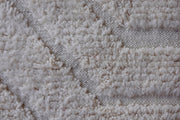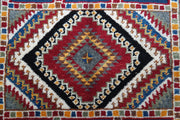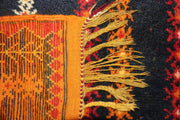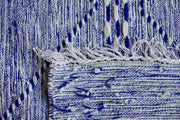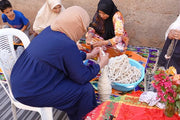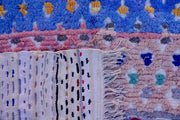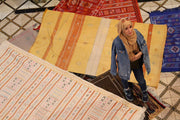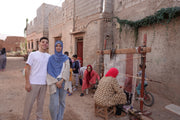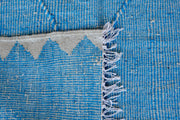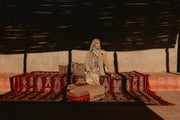The Art Behind the Desert Dream Masterpiece
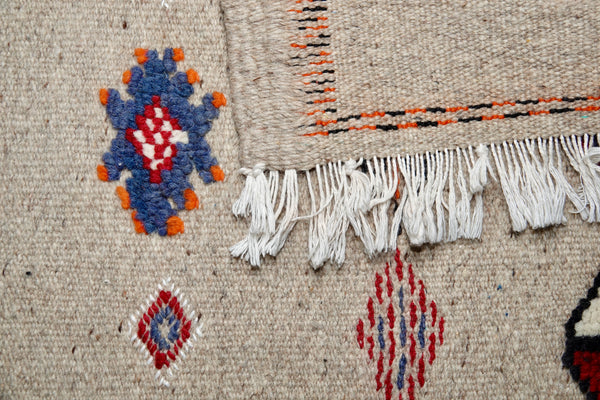
Step into a room with a handwoven Berber rug, and something changes. The space feels warmer, more grounded. But beyond its aesthetic pull, a true Moroccan rug carries meaning—ancestral, artistic, emotional. The Desert Dream Masterpiece is no exception. It’s a story told in thread, woven by the hands of Amazigh (Berber) women from the village of Taznakht, Morocco. Each motif, color, and knot offers a glimpse into their world—their prayers, memories, and lived experiences.
To appreciate the art behind it is to learn how to read it.
Understand the Symbols: What Each Shape Reveals
Before anything else, learn to recognize the patterns. Look closely at the rug. You might see a series of diamond chains. In Berber symbolism, diamonds often represent femininity and fertility. Repeating V shapes? These resemble mountains, anchoring the rug to land and lineage. Circular tufted bursts suggest the sun or tribal insignias. These are not decorative accidents. They are intentional, sacred.
Here’s what to do next: Choose one symbol that appears more than once in your rug. Trace it with your finger. Feel the repetition. Consider what it might have meant for the weaver to repeat that symbol, row after row. This is not just design. It’s devotion.
Learn the Language of Color
The colors in the Desert Dream Masterpiece aren’t chosen on a whim. Each shade is intentional, often created using natural dyes from plants, roots, and minerals. Madder root gives red—symbolizing strength and protection. Walnut shells turn wool black, evoking ancestry and grounding. Indigo leaves create deep blues, linked to water and blessings. Saffron flowers bring yellow and orange—a nod to sun, energy, and life.
If you have a rug of your own, try this: Take a photo and zoom in. Identify the dominant colors. Then research their natural dye sources. Understanding this alone connects you more deeply to the rug’s origin and the weaver’s intention.
Observe the Structure: Layout Is a Language
Berber rugs, especially Akhnif rugs like this one, often mix flatweave kilim with tufted or embroidered symbols. This duality adds texture and dimension—but it also mirrors life’s contrasts: the everyday and the sacred, the plain and the profound.
Many weavers follow a horizontal rhythm, repeating symbols in rows. But some introduce shifts—a break in pattern, a sudden tuft, a shift in symmetry. These are not mistakes. They are markers of emotion, memory, or life events woven into the textile.
Want to read your rug more intentionally? Start here: Find a section where the pattern shifts or breaks. Ask yourself why. What might have happened in the weaver’s life during that moment? Then imagine the rhythm of her hands moving across the loom, weaving thought into form.
Connect With the Artisan and Remember the Hands That Made It
Behind every Berber rug is a woman. Often a mother, a daughter, a sister. She doesn’t follow a printed pattern. Her design lives in her memory, her intuition, her experience. She may weave in silence, or she may sing softly to herself. Either way, she weaves her world into the wool.
To honor this: display your rug with intention. Let it breathe. Share its story when guests ask about it. You don’t need to have all the answers. A simple "This was handwoven by a Berber woman in Taznakht, every symbol carries meaning" is enough to open a deeper conversation.
Bring the Rug Into Your Space with Meaning
A rug like the Desert Dream Masterpiece isn’t just decor. It’s a cultural bridge. A visual prayer. A legacy in wool. Treat it that way.
Here are three steps to begin:
-
Choose where to place it based on intention—in a reading nook, at the foot of your bed, or in the entryway to ground your space.
-
Pair it with natural textures—wood, linen, clay—to allow its patterns and colors to shine.
-
Sit with it. Literally. Let your hand rest on its surface. Notice how it feels different from a machine-made rug. That difference is presence.
When a Rug Becomes a Story Worth Sharing
The Desert Dream Masterpiece is not mass-produced. It was made by hand, over weeks or months, by a woman who inherited her skill through generations. She wove not just for income, but to preserve a legacy.
When you bring a rug like this into your life, you don’t just add warmth to a room. You participate in something much deeper: cultural preservation, artistic exchange, and quiet storytelling.
So the next time someone asks about that beautiful rug in your home, don’t just say, "It’s from Morocco."
Say, "It’s called the Desert Dream Masterpiece. Let me tell you what it means."
-
Posted in
Berber rug meaning, products



